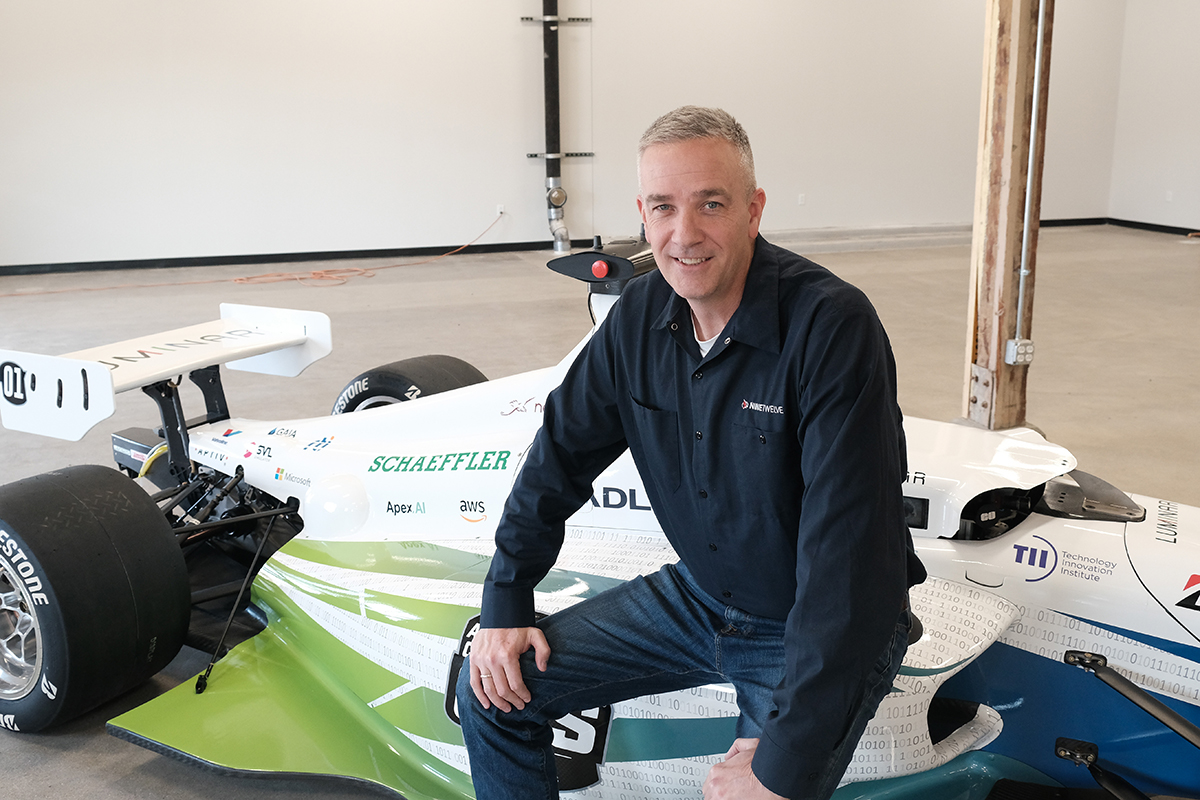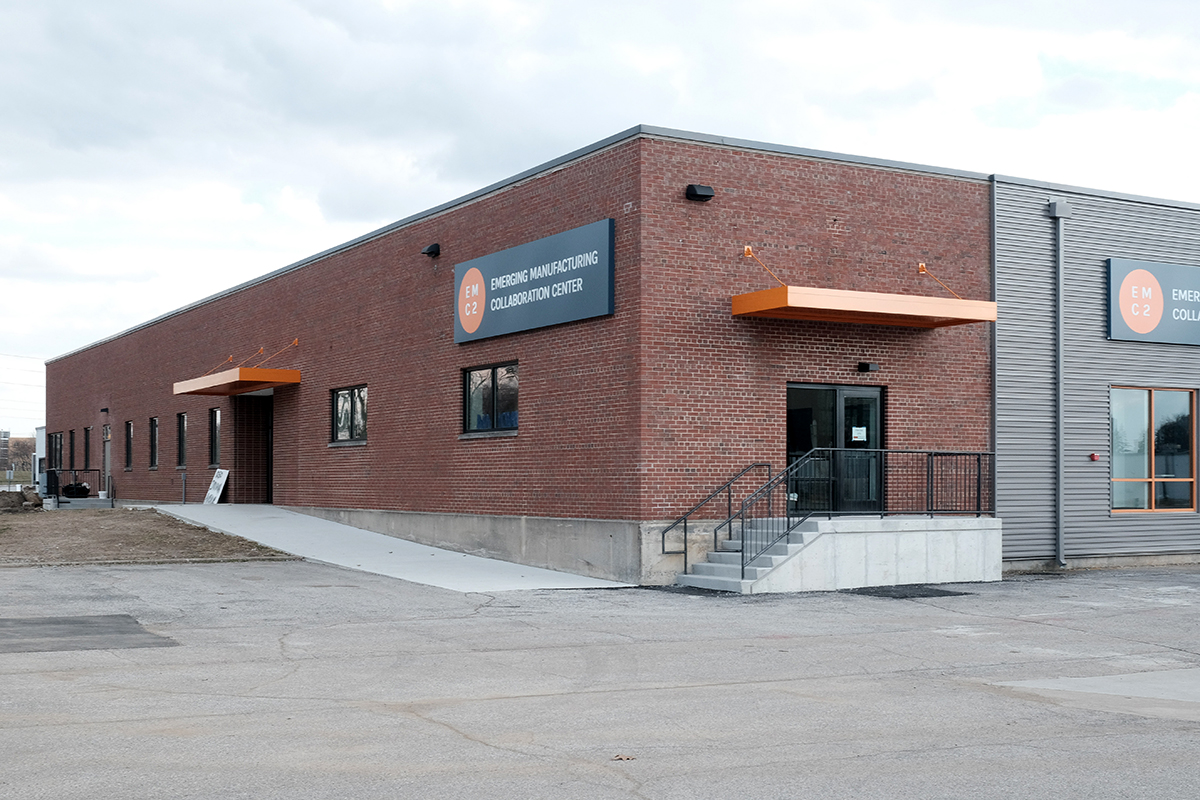Subscriber Benefit
As a subscriber you can listen to articles at work, in the car, or while you work out. Subscribe NowA new facility in the 16 Tech Innovation District—the Emerging Manufacturing Collaboration Center—aims to help Hoosier manufacturers remain competitive in the age of advanced technology.
Called EMC2 for short, the 61,250-square-foot facility is at 1250 Indiana Ave., near the southern entrance to the developing innovation district that sits just across Fall Creek from IUPUI. Part collaboration space, part learning lab and part development and testing center, EMC2 is designed to help small to medium-size manufacturers discover and adopt new technologies.
Two big-name international companies are already on board, along with some local partners.
The 3D-printing equipment manufacturer GE Additive, a division of GE Aviation, has signed on as an anchor tenant and will bring one of its state-of-the-art binder-jet printers, which can produce 3D printed parts made of metal.

Amazon Web Services, or AWS, is also involved in the facility through its participation in Energy INsights. Launched this month at EMC2, Energy INsights shows manufacturers how they can use artificial intelligence and data analytics to reduce their energy costs.
“We won’t be just a museum. We’ll be a place where you actively come and do things,” said EMC2 Director Kent Anderson. Anderson is also chief operating officer at Indianapolis-based NineTwelve Institute, which helps industry, government and academic players collaborate on advanced technology initiatives.
The facility is especially crucial, its supporters say, as manufacturing moves into what’s commonly called Industry 4.0: the use of advanced technologies like 3D printing, data analytics and machine learning to lower costs and improve operations.
And a successful transition to Industry 4.0 matters a lot in Indiana, where manufacturing accounts for 26% of the gross state product and 16% of jobs.
“Manufacturing is critical to our state’s economy, and this facility is designed to help highlight what technologies are disrupting manufacturing,” said Dave Roberts, chief innovation officer at the Indiana Economic Development Corp.
The IEDC provided a $3 million challenge grant to help launch the $7.5 million facility, and EMC2 is financing the remaining $4.5 million. Once the facility is fully up and running, it will generate revenue from a combination of leases and membership fees from those who want to access the facility as a type of coworking space.
Filling up
To date, five tenants have signed on at EMC2: GE Additive; a Massachusetts-based battery company called 24M Technologies Inc.; the Indiana 5G Zone, which will be moving to EMC2 from its current downtown site; the IEDC; and the Indy Autonomous Challenge.
The first tenants have already started to move in, though the facility is not quite complete—a large room at the rear of the building, for instance, hasn’t yet been subdivided into tenant spaces for the Indy Autonomous Challenge and 24M, and GE Additive hasn’t yet moved in its 3D printing equipment.
A grand opening is planned for late May.
Once the five existing tenants are up and running, Anderson said, they’ll take up close to half of the building’s leasable space. EMC2 is working to recruit other tenants to fill up the rest.
The facility includes office space, classrooms and hands-on space for prototyping, testing, engineering and research/development.
Anderson said he envisions people using the space to develop and learn about a range of manufacturing-related technologies. “It is from A to Z.”
But to start, he predicted, much of EMC2’s activity will center on things GE Additive and AWS have to offer.
AWS is one of four partners in the Energy INsights program, along with Indianapolis-based Energy Systems Network, EMC2 and the IEDC. The program launched as a pilot last fall and became available statewide this month.
Participants can install sensors in their manufacturing area, collect data and transfer it to an AWS account where it’s stored, analyzed and modeled using artificial intelligence. The participating company then receives the result of that analysis, with insights it can use to help reduce energy costs.
Industry 4.0 can seem intangible and hard to grasp, Roberts said, but energy use is something every manufacturer thinks about. That, he said, makes Energy INsights the perfect vehicle for introducing companies to Industry 4.0. “It’s relevant in a real and tangible way.”
Once companies participate in Energy INsights, the hope is that they’ll discover other ways they can use data analytics and advanced technology to improve operations.
Thanks to a $5 million grant from the IEDC, small to medium-size manufacturers can participate in the program at no cost. Larger companies will pay up to $25,000, based on their annual revenue.
Anderson said he’s set an admittedly ambitious goal of getting 100 manufacturers from around the state to participate in Energy INsights over the next year.

Printing parts
GE Additive’s presence at EMC2 means 3D printing will be another area of emphasis at the facility.
GE Additive was formed in 2016 as a stand-alone division of GE Aviation. The company is headquartered in the Cincinnati suburb of West Chester, Ohio.
EMC2 will be the company’s first U.S. collaboration site that educates customers and potential customers about its binder-jet technology. Companies will be able to test out its 3D metal printer.
“We think this could help lower the barrier to entry for folks,” said Josh Mook, GE Additive’s chief engineer and innovation leader. “Indianapolis is a fantastic location for collaboration.”
Mook said 3D metal printing has been in use for several years, but mostly to produce low-volume parts in the medical and aerospace industries, including in GE Aviation engines. The technology has only recently become fast enough to be a viable option for high-volume production—parts produced in the millions per year in the automotive industry, for instance.
“That is the frontier that we’re crossing right now,” Mook said.
Compared with traditional manufacturing methods, where parts are cut or shaped from larger pieces of metal, 3D printing is less wasteful. Manufacturers can also reduce their costs because less human labor is required, and one 3D printer can be quickly reset to make a variety of parts—opening up the possibility of bringing more manufacturing in-house and simplifying supply chains.
“I think the time is really right, for all these reasons, for additive to make its way,” Mook said.
The collaborative space at EMC2, he said, should help GE win new customers because they can see the technology in use and test it out before purchase. It will also be a place where technology partners can come to refine their integrations. A company that provides cobots, for instance, could visit EMC2 to figure out the details of how its technology can work with GE Additive’s.
Fred Cartwright, president and CEO of Indianapolis-based Conexus Indiana, said he’s excited about the EMC2’s possibilities. Conexus, an initiative of the Central Indiana Corporate Partnership, promotes the state’s advanced manufacturing and logistics industries.
Indiana’s manufacturing productivity relative to other states’ has been slipping in recent years, Cartwright said, in part due to lack of investment and in part because of workforce shortages.
“One way to improve that productivity is to introduce this digital technology, Industry 4.0 technology,” he said. “EMC2 is a way to accomplish that.”
Cartwright said Conexus and EMC2 have already started collaborating, working to determine how Conexus can help advance the Energy INsights program.
Looking ahead, Roberts said, the IEDC envisions EMC2 as a first step in a larger effort. “We see an opportunity for these kind of facilities to be peppered throughout the state.”•
Please enable JavaScript to view this content.





So IEDC gifted by hairdo guy Pittman $3M to start the gig, Pittman buys the building and IEDC rents from him. “Filling up” space you also have Pittman renting from Pittman.
IEDC gave Pittman and his wife $46M, where around 20% stays as the Pittman’s fee for cameoing.
And they are not even good cameos.